engine MERCEDES-BENZ C-Class COUPE 2013 CL204 User Guide
[x] Cancel search | Manufacturer: MERCEDES-BENZ, Model Year: 2013, Model line: C-Class COUPE, Model: MERCEDES-BENZ C-Class COUPE 2013 CL204Pages: 350, PDF Size: 4.81 MB
Page 20 of 350
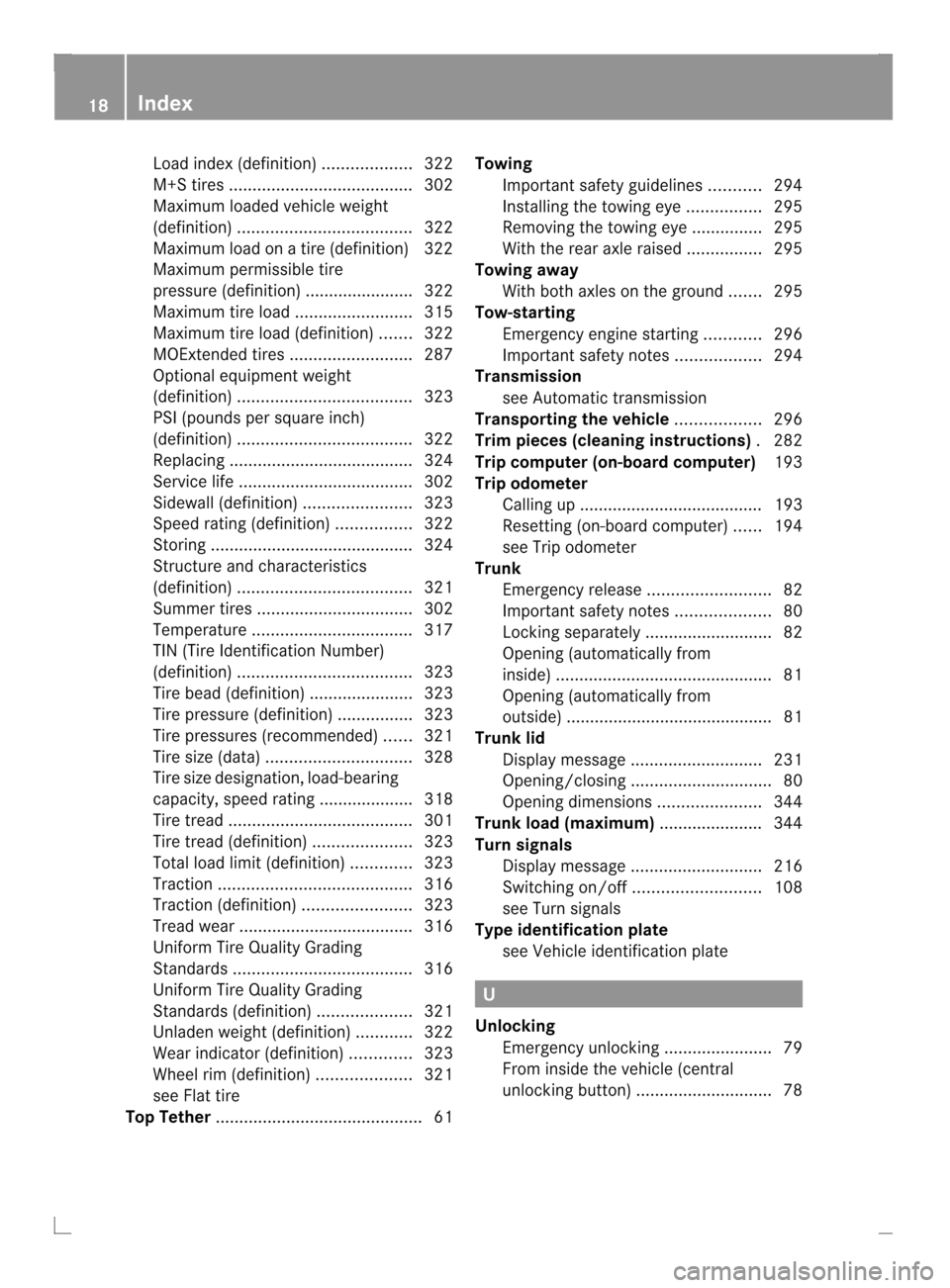
Load index (definition)
...................322
M+S tires ....................................... 302
Maximum loaded vehicle weight
(definition) ..................................... 322
Maximum load on a tire (definition) 322
Maximum permissible tire
pressure (definition) ....................... 322
Maximum tire loa d......................... 315
Maximum tire load (definition) .......322
MOExtended tires ..........................287
Optional equipment weight
(definition) ..................................... 323
PSI (pounds per square inch)
(definition) ..................................... 322
Replacing ....................................... 324
Service life ..................................... 302
Sidewall (definition) .......................323
Speed rating (definition) ................322
Storing ........................................... 324
Structure and characteristics
(definition) ..................................... 321
Summer tires ................................. 302
Temperature .................................. 317
TIN (Tire Identification Number)
(definition) ..................................... 323
Tire bea d(definition) ...................... 323
Tire pressure (definition) ................323
Tire pressures (recommended )...... 321
Tire size (data) ............................... 328
Tire size designation, load-bearing
capacity, speed rating .................... 318
Tire tread ....................................... 301
Tire tread (definition) .....................323
Total load limit (definition) .............323
Traction ......................................... 316
Traction (definition) .......................323
Trea dwear ..................................... 316
Uniform Tire Quality Grading
Standard s...................................... 316
Uniform Tire Quality Grading
Standard s(definition) .................... 321
Unladen weight (definition) ............322
Wea rindicato r(definition) .............323
Whee lrim (definition ).................... 321
see Flat tire
Top Tether ............................................ 61Towing
Important safety guidelines ...........294
Installing the towing eye ................295
Removing the towing eye. ..............295
With the rear axle raised ................295
Towing away
With both axles on the ground .......295
Tow-starting
Emergency engine starting ............296
Important safety notes ..................294
Transmission
see Automatic transmission
Transporting the vehicle ..................296
Trim pieces (cleaning instructions) .282
Trip computer (on-board computer) 193
Trip odometer Calling up ....................................... 193
Resetting (on-board computer) ......194
see Trip odometer
Trunk
Emergency release ..........................82
Important safety notes ....................80
Locking separatel y........................... 82
Opening (automatically from
inside) .............................................. 81
Opening (automatically from
outside) ............................................ 81
Trunk lid
Display message ............................ 231
Opening/closing .............................. 80
Opening dimensions ......................344
Trunk load (maximum) ......................344
Turn signals Display message ............................ 216
Switching on/off ........................... 108
see Turn signals
Type identification plate
see Vehicle identification plate U
Unlocking Emergency unlocking .......................79
From inside the vehicle (central
unlocking button) ............................. 7818
Index
Page 21 of 350

V
Vanity mirror (in the sun visor) ........ 254
Vehicle Data acquisition ............................... 26
Display message ............................ 230
Emergency locking ........................... 79
Emergency unlocking .......................79
Equipment ....................................... 22
Individua lsettings .......................... 200
Limited Warranty ............................. 26
Loading .......................................... 311
Locking (in an emergency) ...............79
Locking (SmartKey) .......................... 72
Lowering ........................................ 328
Maintenance .................................... 23
Parking for a long period ................ 152
Pulling away ................................... 136
Raising ........................................... 325
Reporting problems .........................26
Securing from rolling away ............325
Towing away .................................. 294
Transporting .................................. 296
Unlocking (in an emergency) ...........79
Unlocking (SmartKey) ......................72
Vehicle data ................................... 344
Vehicle data ....................................... 344
Vehicle dimensions ...........................344
Vehicle emergency locking ................79
Vehicle identification number see VIN
Vehicle identification plate ..............336
Vehicle tool kit .................................. 286
Video (DVD) ........................................ 197
VIN ...................................................... 336W
Warning and indicator lamps ABS ................................................ 236
Brakes ........................................... 236
Check Engine ................................. 242
Coolant .......................................... 243
Distance warning ........................... 245
DISTRONI CPLUS ........................... 245
ESP ®
.............................................. 238
ESP ®
OFF ....................................... 239
Fuel tank ........................................ 242 Overview
.......................................... 32
PASSENGER AIR BAG OFF
indicator lamp .................................. 46
Reserve fuel ................................... 242
Seat bel t........................................ 234
SPORT handling mode ...................239
SRS ................................................ 241
Tire pressure monitor ....................246
Warranty ............................................ 336
Washer fluid Display message ............................ 232
Wheel bol ttightening torque ...........328
Wheel chock ...................................... 325
Wheels Changing awheel .......................... 324
Checking ........................................ 301
Cleaning ......................................... 279
Cleaning (warning) .........................324
Emergency spare wheel .................331
Important safety notes ..................300
Interchanging/changing ................324
Mounting anew wheel ................... 327
Mounting awheel .......................... 324
Removing awheel .......................... 327
Storing ........................................... 324
Tightening torque ........................... 328
Whee lsize/tir esize ....................... 328
Window curtain air bag
Display message ............................ 213
Operation ........................................ .46
Windows
see Side windows
Windshield
Defrosting ...................................... 127
see Windshield
Windshiel dwasher fluid
see Windshield washer system
Windshield washer system ..............277
Notes ............................................. 342
Windshiel dwipers
Problem (malfunction) ...................119
Replacing the wiper blades ............117
Switching on/off ........................... 116
Winte rdriving
Important safety note s.................. 302
Slippery road surfaces ...................157
Snow chains .................................. 303 Index
19
Page 23 of 350
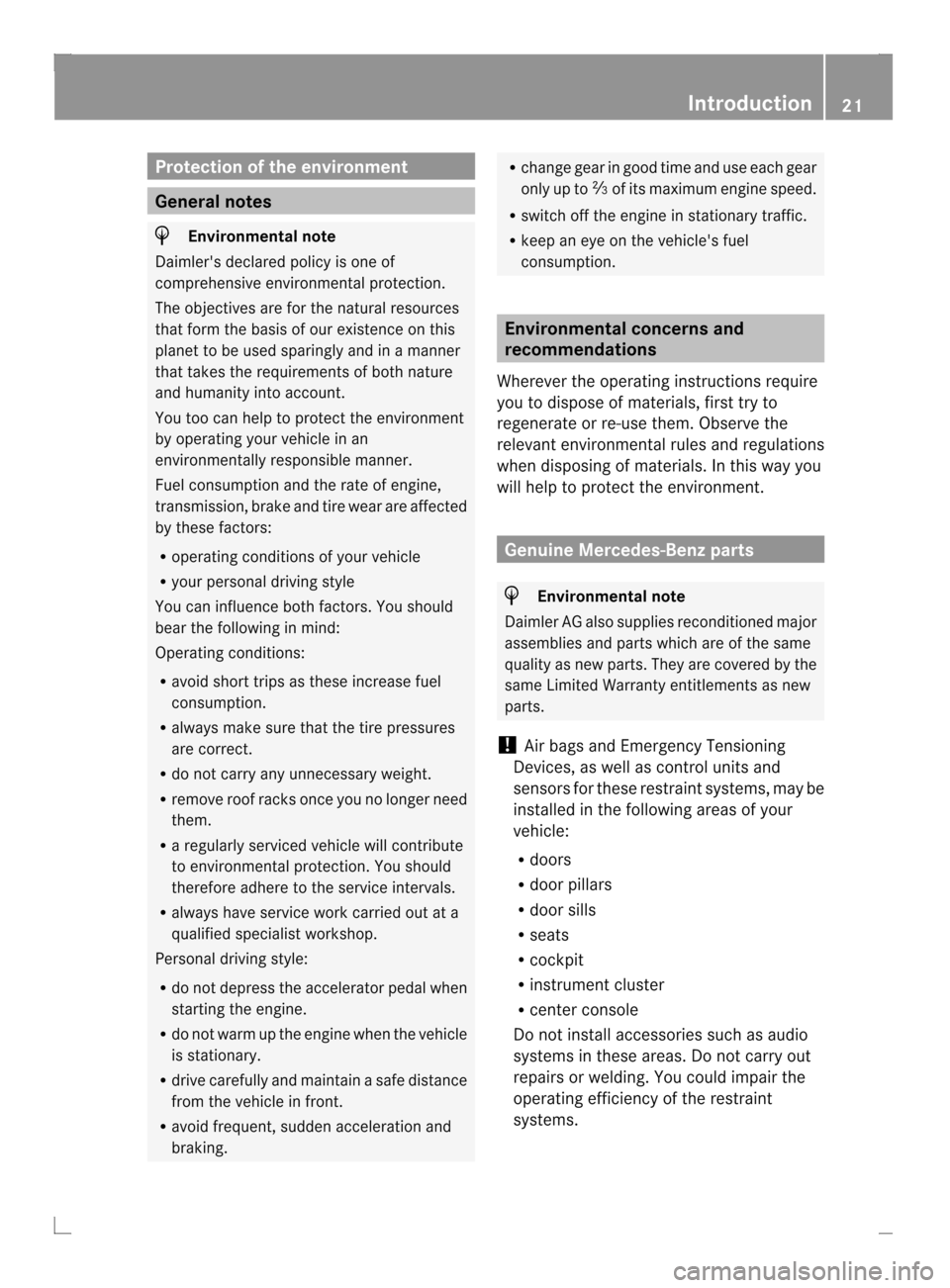
Protection of the environment
General notes
H
Environmental note
Daimler's declared policy is one of
comprehensive environmental protection.
The objectives are for the natural resources
that form the basis of our existence on this
planet to be used sparingly and in a manner
that takes the requirements of both nature
and humanity into account.
You too can help to protect the environment
by operating your vehicle in an
environmentally responsible manner.
Fuel consumption and the rate of engine,
transmission, brake and tire wear are affected
by these factors:
R operating conditions of your vehicle
R your personal driving style
You can influence both factors. You should
bear the following in mind:
Operating conditions:
R avoid short trips as these increase fuel
consumption.
R always make sure that the tire pressures
are correct.
R do not carry any unnecessary weight.
R remove roof racks once you no longer need
them.
R a regularly serviced vehicle will contribute
to environmental protection. You should
therefore adhere to the service intervals.
R always have service work carried out at a
qualified specialist workshop.
Personal driving style:
R do not depress the accelerator pedal when
starting the engine.
R do not warm up the engine when the vehicle
is stationary.
R drive carefully and maintain a safe distance
from the vehicle in front.
R avoid frequent, sudden acceleration and
braking. R
change gear in good time and use each gear
only up to 0001of its maximum engine speed.
R switch off the engine in stationary traffic.
R keep an eye on the vehicle's fuel
consumption. Environmental concerns and
recommendations
Wherever the operating instructions require
you to dispose of materials, first try to
regenerate or re-use them. Observe the
relevant environmental rules and regulations
when disposing of materials. In this way you
will help to protect the environment. Genuine Mercedes-Benz parts
H
Environmental note
Daimler AG also supplies reconditioned major
assemblies and parts which are of the same
quality as new parts. They are covered by the
same Limited Warranty entitlements as new
parts.
! Air bags and Emergency Tensioning
Devices, as well as control units and
sensors for these restraint systems, may be
installed in the following areas of your
vehicle:
R doors
R door pillars
R door sills
R seats
R cockpit
R instrument cluster
R center console
Do not install accessories such as audio
systems in these areas. Do not carry out
repairs or welding. You could impair the
operating efficiency of the restraint
systems. Introduction
21 Z
Page 24 of 350
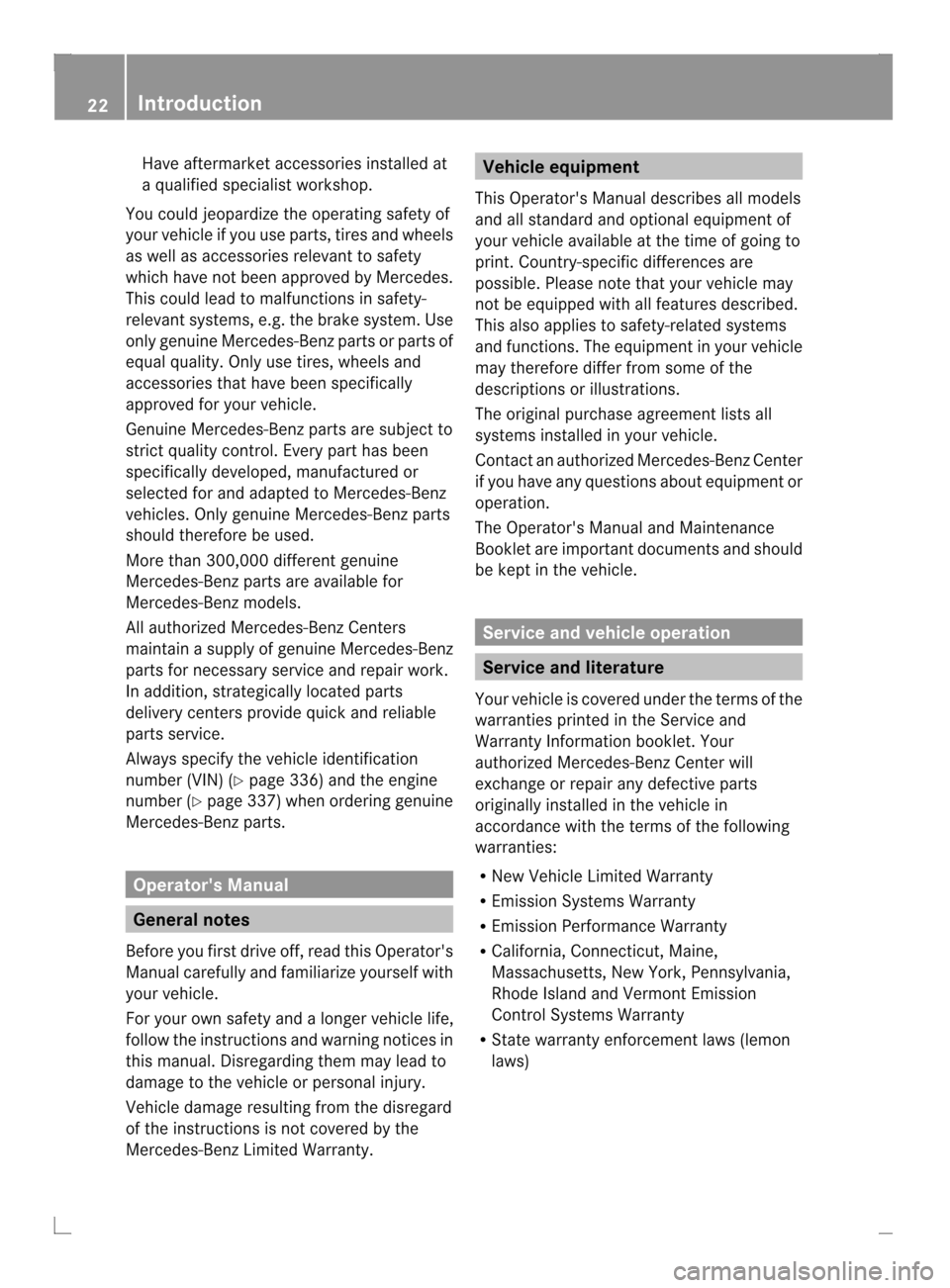
Have aftermarke
taccessories installed at
a qualified specialist workshop.
You could jeopardize the operating safety of
your vehicle if you use parts, tires and wheels
as well as accessories relevant to safety
which have not bee napproved by Mercedes.
This could lead to malfunctions in safety-
relevant systems, e.g. the brake system .Use
only genuine Mercedes-Benz parts or parts of
equal quality. Only use tires, wheels and
accessories that have been specifically
approved for your vehicle.
Genuine Mercedes-Benz parts are subject to
strict quality control. Every part has been
specifically developed, manufactured or
selected for and adapted to Mercedes-Benz
vehicles. Only genuine Mercedes-Benz parts
should therefore be used.
More than 300,000 different genuine
Mercedes-Benz parts are available for
Mercedes-Benz models.
All authorized Mercedes-Benz Centers
maintain a supply of genuine Mercedes-Benz
parts for necessary service and repair work.
In addition, strategically located parts
delivery centers provide quick and reliable
parts service.
Always specify the vehicle identification
number (VIN) (Y page 336) and the engine
number (Y page 337) when ordering genuine
Mercedes-Benz parts. Operator's Manual
General notes
Before you first drive off, read this Operator's
Manual carefully and familiarize yourselfw ith
your vehicle.
For your own safety and a longer vehicle life,
follow the instructions and warning notices in
this manual. Disregarding the mmay lead to
damage to the vehicle or personal injury.
Vehicle damage resulting from the disregard
of the instructions is not covered by the
Mercedes-Ben zLimited Warranty. Vehicle equipment
This Operator's Manual describes all models
and all standard and optional equipmen tof
your vehicle available at th etime of going to
print. Country-specific differences are
possible .Please note that your vehicle may
not be equipped with all features described.
This also applies to safety-related systems
and functions .The equipment in your vehicle
may therefore differ from some of the
descriptions or illustrations.
The original purchase agreement lists all
systems installed in your vehicle.
Contact an authorized Mercedes-Ben zCenter
if you have any questions about equipment or
operation.
The Operator's Manual and Maintenance
Booklet are important documents and should
be kept in the vehicle. Service and vehicle operation
Service and literature
Your vehicle is covered under the terms of the
warranties printed in the Service and
Warranty Information booklet. Your
authorized Mercedes-BenzC enter will
exchange or repair any defective parts
originally installed in the vehicle in
accordance with the term softhe following
warranties:
R New Vehicle Limited Warranty
R Emission Systems Warranty
R Emission Performance Warranty
R California, Connecticut, Maine,
Massachusetts, New York, Pennsylvania,
Rhode Island and Vermont Emission
Control Systems Warranty
R State warranty enforcement laws (lemon
laws) 22
Introduction
Page 26 of 350

If you have purchased a used car, please send
us the "Notification of Used Car Purchase" in
the Service and Guarantee booklet or simply
call the Mercedes-Benz Customer Assistance
Center (USA) at the hotline number
1-800-FOR-MERCedes(1-800-367-6372) or
Customer Service (Canada) at
1-800-387-0100. Vehicle operation outside the USA
and Canada
If you plant o operate your vehicle in foreign
countries, please be aware that:
R service facilities or replacement parts may
not be readily available.
R unleaded fuel for vehicles with a catalytic
converter may not be available. Leaded fuel
may cause damage to the catalytic
converter.
R the fuel may have a considerably lower
octane rating. Unsuitable fuel can cause
engine damage.
Some Mercedes-Benz models are available
for delivery in Europe through our European
Delivery Program. For details, consult an
authorized Mercedes-Benz Center or write to
one of the following addresses.
In the USA
Mercedes-Benz USA, LLC
European Delivery Department
One Mercedes Drive
Montvale, NJ 07645-0350
In Canada
Mercedes-Benz Canada, Inc.
European Delivery Department
98 Vanderhoof Avenue
Toronto, Ontario M4G 4C9 Operating safety
Important safety notes
G
WARNING
If you do not have the prescribed service/
maintenance work or any required repairs
carried out, this can result in malfunctions or
system failures. There is a risk of an accident.
Always have the prescribed service/
maintenance work as well as any required
repairs carried out at a qualified specialist
workshop. G
WARNING
If you switch off the ignition while driving,
safety-relevant functions are only available
with limitations, or not at all. This could affect,
for example, the power steering and the brake
boosting effect .You will require considerably
more effort to steer and brake. There is a risk
of an accident.
Do not switch off the ignition while driving. G
WARNING
Modifications to electronic components, their
software as well as wiring can impair their
function and/or the function of other
networked components. In particular,
systems relevant to safety could also be
affected. As a result, these may no longer
function as intended and/or jeopardize the
operating safety of the vehicle. There is an
increased risk of an accident and injury.
Never tamper with the wiring as well as
electronic components or their software. You
should have all work to electrical and
electronic equipment carried out at a qualified
specialist workshop.
There is a risk of damage to the vehicle if:
R the vehicle becomes stuck, e.g. on a high
curb or an unpaved road
R you drive too fast over an obstacle, e.g. a
curb or a hole in the road
R a heavy object strikes the undercarriage or
parts of the chassis. 24
Introduction
Page 27 of 350

In situations like this, the body, the
undercarriage, chassis parts, wheels or tires
could be damaged withou tthe damage being
visible. Components damaged in this way can
unexpectedly fail or, in the case of an
accident, no longer withstand the strain they
are designed to.
If the underbody paneling is damaged,
combustible materials such as leaves, grass
or twigs can gather between the underbody
and the underbody paneling. If these
materials come in contact with hot parts of
the exhaust system for an extended period,
they can catch fire.
Have the vehicle checked and repaired
immediately at a qualified specialist
workshop. If on continuing your journey you
notice that driving safety is impaired, pull over
and stop the vehicle immediately, paying
attention to road and traffic conditions. In
such cases, visit a qualified specialist
workshop. Declarations of conformity
Vehicle components which receive
and/or transmit radio waves USA:
"The wireless devices of this vehicle
comply with Part 15 of the FCC Rules.
Operation is subject to the following two
conditions: 1) These devices may not cause
harmful interference, and 2) These devices
must accept any interference received,
including interference that may cause
undesired operation. Changes or
modifications not expressly approved by the
party responsible for compliance could void
the user’s authority to operate the
equipment."
Canada: "The wireless devices of this vehicle
comply with Industry Canada license-exempt
RSS standard(s). Operation is subject to the
following two conditions: (1) These devices
may not cause interference, and (2) These
devices must accept any interference, including interference that may cause
undesired operation of the device." Diagnostics connection
The diagnostics connection is only intended
for the connection of diagnostic equipment at
a qualified specialist workshop. G
WARNING
If you connect equipment to the diagnostics
connection in the vehicle, it may affect the
operation of the vehicle systems. As a result,
the operating safety of the vehicle could be
affected. There is a risk of an accident.
Do not connect any equipment to a
diagnostics connection in the vehicle. G
WARNING
Objects in the driver's footwell can restrict the
pedal travel or obstruct adepressed pedal.
The operating and road safety of the vehicle
is jeopardized. There is a risk of an accident.
Make sure that all objects in the vehicle are
stowed correctly, and that they cannot enter
the driver's footwell. Install the floormats
securely and as specified in order to ensure
sufficien tclearance for the pedals. Do not use
loose floormats.
! If the engine is switched off and
equipmen tonthe diagnostics connection
is used, the starter battery may discharge.
Connecting equipment to the diagnostics
connection can lead to emissions monitoring
information being reset, for example. This
may lead to the vehicle failing to meet the
requirements of the next emissions test
during the main inspection. Qualified specialist workshop
An authorized Mercedes-Ben zCenter is a
qualified specialist workshop. It has the
necessary specialist knowledge, tools and
qualifications to correctly carry out the work Introduction
25 Z
Page 34 of 350
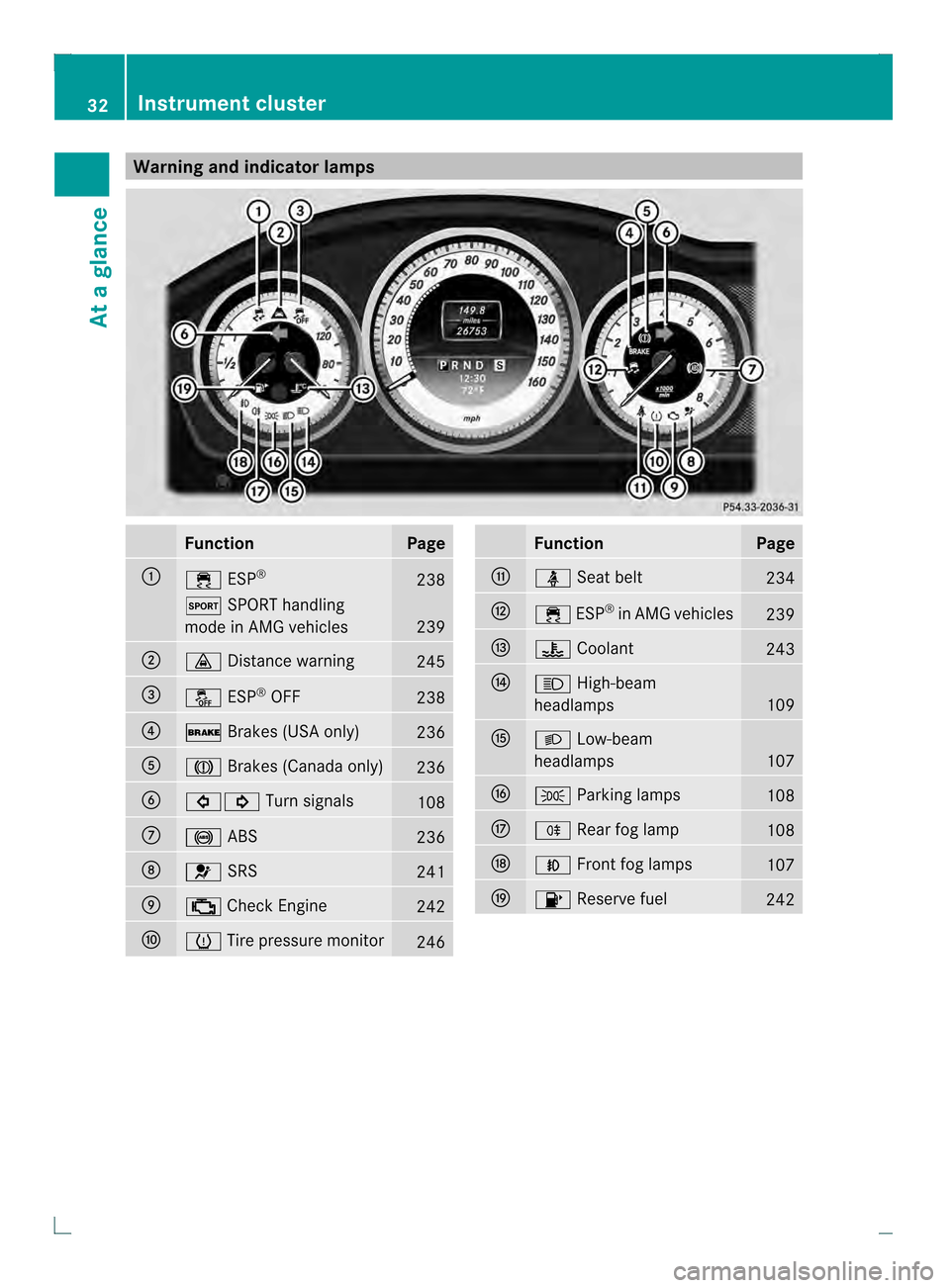
Warning and indicator lamps
Function Page
0002
000D
ESP® 238
0003
SPORT handling
mode in AMG vehicles 239
0003
000B
Distance warning 245
0022
0015
ESP®
OFF 238
0021
000C
Brakes (USA only) 236
001F
0006
Brakes (Canada only) 236
0020
00070006
Turn signals 108
0012
0018
ABS 236
0013
001E
SRS 241
0014
000C
Check Engine 242
0015
0012
Tire pressure monitor 246 Function Page
0016
0012
Seat belt 234
0018
000D
ESP®
in AMG vehicles 239
0019
000A
Coolant 243
001A
000A
High-beam
headlamps 109
001B
000B
Low-beam
headlamps 107
001D
0014
Parking lamps 108
001E
000E
Rearfog lamp 108
0023
000C
Front fog lamps 107
0024
000E
Reserve fuel 24232
Instrument clusterAt a glance
Page 43 of 350

SRS (Supplemental Restraint System)
Introduction SRS consists of:
R
The 001E SRS warning lamp
R Air bags
R Air bag control unit (with crash sensors)
R Emergency Tensioning Devices
R Belt force limiters
SRS reduces the risk of occupants coming
into contact with the vehicle's interior in the
event of an accident. It can also reduce the
effect of the forces to which occupants are
subjected during an accident.
SRS warning lamp SRS functions are checked regularly when
you switch on the ignition and when the
engine is running. Therefore, malfunctions
can be detected in good time.
The 001E SRS warning lamp in the instrument
cluster lights up when the ignition is switched
on. It goes out no later than a few seconds
after the engine is started.
The SRS components are in operational
readiness when the 001ESRS warning lamp
goes out while the engine is running. G
WARNING
The SRS self-chec khas detected a
malfunction if the 001ESRS indicator lamp:
R does no tlight up at all
R does not go out after approximately four
seconds after the engine is started
R comes on after the engine was started or
while driving.
For your safety, Mercedes-Ben zstrongly
recommends tha tyou have the system
checked as soon as possible at an authorized
Mercedes-Benz Center. SRS may otherwise
fail to activate when it is needed in the event
of an accident, which could lead to serious or
fatal injuries. SRS might also be activated unexpectedly and unnecessarily, which could
also result in injury.
In addition, work carried out improperly on
SRS may render SRS inoperative or cause
unintended air bag deployment. Work on the
SRS system should only be carried out by
qualified specialist personnel. Consult an
authorized Mercedes-Benz Center.
If it is necessary to modify an air bag system
to accommodate a person with disabilities,
contact an authorized Mercedes-Benz Center
for details. USA only: for further information
contact our Customer Assistance center at
1-800-FOR-MERCedes (1-800-367-6372).
Safety guidelines for seat belts,
Emergency Tensioning Devices (ETDs)
and air bags G
WARNING
R Damaged seat belts or seat belts that have
been subjected to stress in an accident
must be replaced. Their anchoring points
must also be checked. Only use seat belts
installed or supplied by an authorized
Mercedes-Benz Center.
R Air bags and pyrotechnic Emergency
Tensioning Devices (ETDs) contain
perchlorate material, which may require
special handling and regard for the
environment.C heck your national disposal
guidelines. California residents, see
www.dtsc.ca.gov/HazardousWaste/
Perchlorate/index.cfm.
R Air bags and ETDs are designed to function
on a one-time-only basis. An air bag or ETD
that has deployed must be replaced.
R Do not pass seat belts over sharp edges.
They could tear.
R Do not make any modification that could
change the effectiveness of the seat belts.
R Do not bleach or dye seat belts as this may
severely weaken them. In a crash they may
not be able to provide adequate protection.
R No modifications of any kind may be made
to any components or wiring of the SRS. Occupant safety
41Safety
Z
Page 49 of 350

deactivated automatically for certain weight
categories. The 0019001Bindicator lamp
shows you the current status. If the
0019001B indicator lamp lights up, the front-
passenger air bag is disabled.
The system does not deactivate:
R the side impact air bag
R the pelvis air bag
R the window curtain air bag
R the Emergency Tensioning Devices
To be classified correctly, the fron tpassenger
must sit:
R with the seat belt fastened correctly
R in a positio nthat is as upright as possible
with their back against the seat backrest
R with their feet on the floor
If the front-passenger's weight is transferred
to another object in the vehicle (e.g. by
leaning on armrests), OCS may not be able to
approximate the occupant's weight category.
If the front-passenger seat, the seat cover or
the seat cushion are damaged, have the
necessary repair work carried out at an
authorized Mercedes-Ben zCenter.
For safety reasons, Mercedes-Benz
recommends that you only use seat
accessories that have been approved by
Mercedes-Benz.
Both the driver and the fron tpassenger
should always observe the 0019001B
indicator lamp to determine whether or not
the fron tpassenger is positioned correctly. G
WARNING
If the 0019001B indicator lamp illuminates
when an adult or someone large rthan a small
individual is in the front passenger seat, have
the front passenger reposition himself or
herself in the seat until the 0019001B
indicator lamp goes out.
In the event of a collision, the air bag control
unit will not allow front passenger front air bag
deployment when the OCS has classified the
front passenger seat occupant as weighing as
much as or less than a typical 12-month-old child in a standard child restraint or if the front
passenger seat is classified as being empty.
When the OCS senses that the front
passenger seat occupant is classified as
being up to or less than the weight of a typical
12-month-old child in a standard child
restraint, the
0019001Bindicator lamp will
illuminate when the engine is started and
remain illuminated. This indicates that the
front passenger front air bag is deactivated.
When the OCS senses that the front
passenger seat is classified as being empty,
the 0019001B indicator lamp will illuminate
when the engine is started and remain
illuminated. This indicates that the front
passenger front air bag is deactivated.
When the OCS senses that the front
passenger seat occupant is classified as
being heavier than the weight of a typical 12-
month-old child seated in astandard child
restraint or as being a small individual (such
as a young teenager or asmall adult), the
0019001B indicator lamp will illuminate for
approximately 6seconds when the engine is
started. Depending on occupant weight
sensor readings from the seat, it will then
remain illuminated or go out. With the
0019001B indicator lamp illuminated, the
fron tpassenger fron tair bag is deactivated.
With the 0019001B indicator lamp out, the
front passenger front air bag is activated.
When the OCS senses that the front
passenger seat occupant is classified as an
adult or someone larger than a small
individual, the 0019001Bindicator lamp will
illuminate for approximately six seconds
when the engine is started and the ngo out.
This indicates that the front passenger front
air bag is activated.
If the 0019001B indicator lamp is illuminated,
the front passenger front air bag is
deactivated and will not be deployed. Occupant safety
47Safety
Z
Page 58 of 350
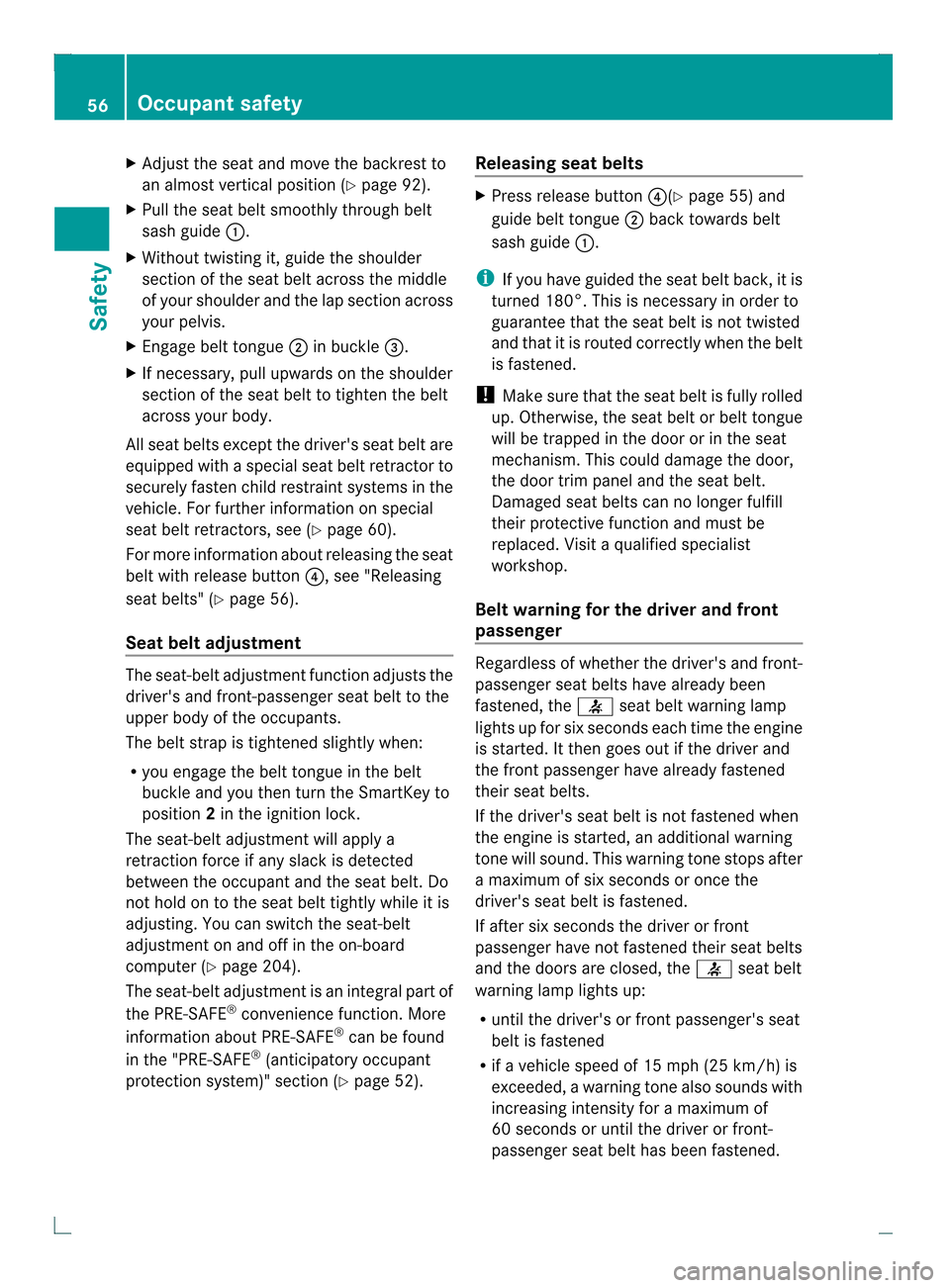
X
Adjust the seat and move the backrest to
an almos tvertical position (Y page 92).
X Pull the seat belt smoothly through belt
sash guide 0002.
X Without twisting it, guide the shoulder
section of the seat belt across the middle
of your shoulder and the lap section across
your pelvis.
X Engage belt tongue 0003in buckle 0022.
X If necessary, pull upwards on the shoulder
section of the seat belt to tighten the belt
across your body.
All seat belts except the driver's seat belt are
equipped with a special seat belt retractor to
securely fasten child restraint systems in the
vehicle. For further information on special
seat belt retractors, see (Y page 60).
For more information about releasing the seat
belt with release button 0021, see "Releasing
seat belts" (Y page 56).
Seat belt adjustment The seat-belt adjustment function adjusts the
driver's and front-passenger seat belt to the
upper body of the occupants.
The belt strap is tightened slightly when:
R
you engage the belt tongue in the belt
buckle and you then turn the SmartKey to
position 2in the ignition lock.
The seat-belt adjustment will apply a
retraction force if any slack is detected
between the occupan tand the sea tbelt. Do
not hold on to the seat belt tightly while it is
adjusting. You can switch the seat-belt
adjustment on and off in the on-board
computer (Y page 204).
The seat-belt adjustment is an integral part of
the PRE-SAFE ®
convenience function. More
information about PRE-SAFE ®
can be found
in the "PRE-SAFE ®
(anticipatory occupant
protection system)" section (Y page 52).Releasing seat belts X
Press release button 0021(Ypage 55) and
guide belt tongue 0003back towards belt
sash guide 0002.
i If you have guided the seat belt back, it is
turned 180°. This is necessary in order to
guarantee that the seat belt is not twisted
and that it is routed correctly when the belt
is fastened.
! Make sure that the seat belt is fully rolled
up. Otherwise, the seat belt or belt tongue
will be trapped in the door or in the seat
mechanism. This could damage the door,
the door trim panel and the seat belt.
Damaged seat belts can no longer fulfill
their protective function and must be
replaced. Visit a qualified specialist
workshop.
Belt warning for the driver and front
passenger Regardless of whether the driver's and front-
passenger seat belts have already been
fastened, the
001Fseat belt warning lamp
lights up for six seconds each time the engine
is started. It then goes out if the driver and
the fron tpassenger have already fastened
their seat belts.
If the driver's seat belt is no tfastened when
the engine is started, an additional warning
tone will sound. This warning tone stops after
a maximum of six seconds or once the
driver's seat belt is fastened.
If after six seconds the driver or front
passenger have no tfastened their seat belts
and the doors are closed, the 001Fseat belt
warning lamp lights up:
R until the driver's or fron tpassenger's seat
belt is fastened
R if a vehicle speed of 15 mph (25 km/h) is
exceeded, a warning tone also sounds with
increasing intensity for a maximum of
60 seconds or until the driver or front-
passenger seat belt has been fastened. 56
Occupant safetySafety